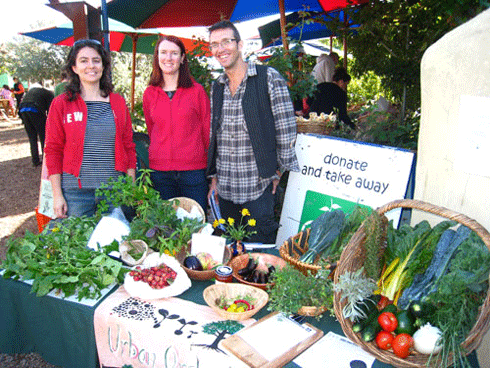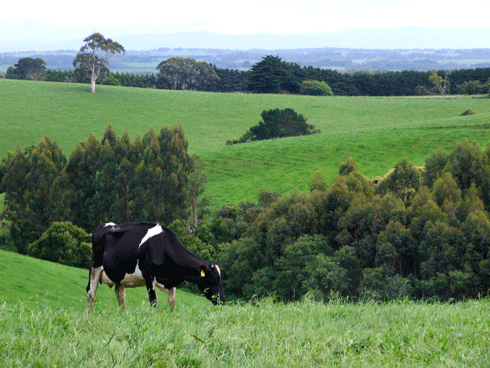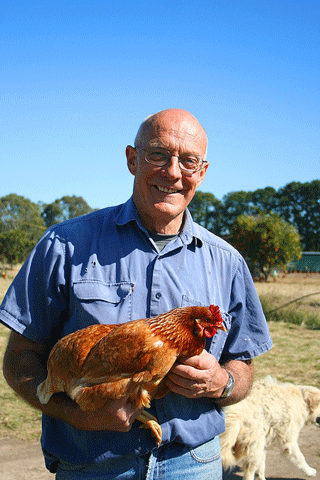
|
Published: 27 February 2012
Food citizens make secure choices
This year, gourmet trendspotters believe that, in addition to embracing sweet cheeses and beer geekery, 2012 will be all about ‘food citizens’ connecting with like-minded communities.
As Australia’s two major supermarket chains conduct a noisy price war, a quiet revolution has been taking place. The past few years have seen the rise of food citizens: urban consumers who actively seek to secure ethically and sustainably produced food and connect with how food is grown and made.
Their interest has led to a rapid proliferation in alternative food sourcing, including farmers’ markets, food co-ops, community gardens and urban orchards, herd shares, neighbourhood cooperatives, fresh produce box schemes, farm gate trails, and informal home-grown produce trading within communities (i.e. food swaps).
The grass roots movement is starting to have an economic impact, with a recent report from the Australian Egg Corporation estimating that backyard chickens now account for nearly 12 per cent of the country’s total annual egg production.
‘We often don’t know the story behind the food we consume, but when you talk to the farmer you have a different perspective on whether something is healthy or not,’ says Nick Ray the founder of Local Harvest, an online hub that helps consumers find local farmers’ markets, community gardens, food swaps, organic and free range producers and community box systems.
‘A sustainable food system relies on us localising at least part of it, and will help make it more resilient to price hikes and potential supply issues associated with fossil fuel and fertiliser shortages.’
Kirsten Larsen from the Victorian Eco-Innovation Lab at the University of Melbourne agrees.
‘As the Queensland floods demonstrated, our current [centralised] food system is vulnerable to disruption, whether that relates to climatic extremes or other interruptions to supply,’ she says.
‘When the central wholesale market in Brisbane went underwater, significant parts of Brisbane’s supply chains were out of action. Organisations like Food Connect [see below] were able to quickly respond and adapt to the situation, partially because the diverse base of smaller suppliers were less affected overall by the flooding, but also because its rich social network enabled people to connect and organise food movements through (and to) flooded and cut-off areas.
‘It’s an example of how a more distributed network for food sourcing increases their strength, resilience, flexibility – and therefore security. Not only do they connect people with farmers, they also increase connections to bigger system change.’

|
|
Every Saturday at CERES environmental centre in Melbourne’s inner north, members of the Urban Orchard Project gather to swap and share excess produce from their backyard gardens, including not only fruit but vegetables, herbs and more.
Credit: CERES
|
Dr Brian Keating, Director of CSIRO’s Sustainable Agriculture Flagship also believes that potential supply disruptions caused by natural disasters, food safety incidents or biosecurity threats are a dimension of food security for countries like Australia that will require closer scrutiny.
‘These may not have been major to date – but there is a chance they may grow in significance in future,’ he says.
‘I doubt whether the world can feed itself from the local food system and backyard vegie gardens, but they have an important role to play in sustainability.
‘The broadscale agricultural mantra of “get big or get out” simply isn’t applicable to all areas.
‘For example, in coastal Australia, land use pressures mean it’s simply not possible to have big farms close to cities, but “staying small, and getting different” by getting connected to the local community provides a service to that community beyond food.
‘In Europe agriculture is close to urban areas and provides landscape amenity, an escape route for the cities and mental health services to their residents. These landscape services and agri-tours, like farm gate trails, offer a multi-value proposition.
‘Encouraging a diversity of different food systems is healthy,’ he comments. ‘We do need to take care when talking about their environmental benefits, however.
‘Saying that something is better just because it’s local, is not always right.’ For example, it is questionable whether animals kept warm in a local barn by a coal-fired power station are better than animals raised outdoors and their meat transported a greater distance to the consumer. ‘These claims need to be based on a full systems analysis,’ concludes Dr Keating.
Pricing for sustainability
While urban consumers benefit in the short-term from discounted supermarket pricing, in the long term it contributes to the cost-price squeeze experienced by Australian farmers. Alternative food-sourcing models are helping breathe new life into troubled agricultural businesses.
‘There is a big disconnect between farmers and consumers, and little understanding of what farmers are forced to do to produce products at the prices supermarkets demand,’ says Vicki Jones from Mountain View Farms in Victoria’s Gippsland.
With 150 grass-fed dairy cows on 300 acres, Ms Jones says that supplying the conventional market would have made it impossible to run the farm sustainably. Instead, she has recently started running a herd share, supplying milk and meat to members from her organic property.
‘Depending on how much milk they need, people buy shares in the herd for $25 each then pay $1.50 a litre for the milk they collect from the cool rooms of organic outlets and other organisations in the area,’ she explains.
Food laws in Australia mean unpasteurised milk has to be labeled as ‘Bath Milk – Not for Human Consumption’. Despite this there is growing public debate and some scientific research around the health benefits of grass-fed raw milk. 1
Interest in the herd share has spread rapidly through word of mouth, she says. One of the reasons people join is Mountain View’s ethical farming practices. To keep a dairy cow producing milk, the cow must produce a calf once a year. The male calves are normally slaughtered at one week, after being separated from their mothers. At Mountain View Farms, these calves are reared on cows that have been retired from the dairy at around 7 years of age.
‘We try to give all of our animals a normal life, and a growing number of people are keen to support that – and us too,’ says Ms Jones. ‘Until we started the herd share, we were struggling, but now it also gives us the chance to earn some income and start paying down the mountain of debt that all farmers carry.’

|
|
Mountain View Farms, Gippsland, Victoria.
Credit: Mountain View Farms
|
Robert Pekin, Founder of Brisbane-based Food Connect, says the enterprise has a backlog of farmers eager to become part of a Community Supported Agriculture (CSA) model (Food Connect now also operates in Sydney).
The Food Connect CSA model brings together small producers with subscribers who want to purchase seasonal, locally grown produce grown within an 80 km radius of central Brisbane. (See Ecos article on Local food for sustainable communities)
‘For too long the market dominance of Australian supermarkets has meant increased pressure on our farmers to provide cheap fruit and vegetables. The result is a mass exodus of farming families walking off the land at the rate of 25 per week,’ he says.
‘By supporting smaller-scale and local enterprises, consumers benefit, receiving seasonal produce that is healthier and more nutritious. Farmers get a fairer price for their work.
‘Food Connect and [Melbourne-based] CERES Fair Food pay farmers as much as 40 cents in the retail dollar for their produce. As a result of these fair farm gate prices, hundreds of farmers in Queensland, NSW and Victoria have stayed on the land.
‘In stark contrast, the last twelve months has seen 30 Queensland dairy farmers abandon their farms as a direct consequence of the milk price wars initiated by the supermarket duopoly.’
One of Food Connect’s farmers is Geoff Buckley, who grows organic fruits, nuts, berries, vegetables and herbs on his family’s property on Queensland’s Mt Tamborine. Half the farm’s produce is sold at the local weekly farmer’s market that Geoff and his wife started 11 years ago, while the rest is sold to Food Connect.
Geoff says while prices are at more of a wholesale level than they might achieve at the farmer’s market, this is compensated for by the large volumes and contracts guaranteeing prices over the term of the contract.
‘Not only is Food Connect ethical and honourable in their dealings,’ he says, ‘their distribution system minimises the time from farmer to consumer.
‘Research by the local Growers’ Association [of which Mr Buckley is president] has shown that it takes about three weeks for avocados to reach the shelves. Supermarkets are more interested in the transportability of a crop and its shelf life than nutritional quality.’
Social value
Some critics say food citizenry is an urban middle class movement. However, according to Robert Pekin, Food Connect’s growing membership comes from a broad cross-section of society, from young mums to uni students and grandmothers, who are united in their search for fresher, better value, ethically sourced produce.
‘Traditionally, these models are marketed at the affluent middle class, but Food Connect’s model is based on affordability,’ Mr Pekin says.
‘As a social enterprise, we also measure ourselves on connections we form with lower socio-economic groups, and work with them to not only provide affordable food but also to teach cooking skills to people that have been relying on takeaway for three-four generations.’
Food Connect is also working on changing the food production model from large-scale operations shaped by traditional agricultural science, to ecologically sustainable, small scale and highly productive set ups that encourage people, especially young people back to the land.
In Australia, Food Connect is involved in the New Farmers’ Pathway, and is also collaborating with La Via Campesina, an international organisation of over 300 million peasant farmers.
According to Ms Larsen, a big part of securing our food system ‘is ensuring that farmers who want to farm can profitably do so’. She points to a recent USDA survey showing that the proliferation of farmers’ markets and other alternative food sourcing models has, for the first time in 40 years, seen more farmers supported, particularly younger ones and those with small operatioons.
‘We need to shift the focus from food production as an agricultural commodity, to making good quality food accessible and available to all sectors of society, improving its ecological outcomes, and being prepared to pay a reasonable price that supports farmers,’ she adds.
‘One of the challenges is how collaboration and competition can be combined to accelerate this movement and the bigger change.
‘Naturally there is competition as people try new things and improve on what's there. There are also common challenges and opportunities - by sharing experiences and ideas, we're learning together how to increase diversity, keep it distributed and scale it up!’
More information
CSIRO and food production: securing our food future
National Food Plan for Australia
Helping Africans solve agricultural challenges
Healthy ecosystems essential for future food security: global report
1 Liesbeth A Smit, Ana Baylin & Hannia Campos (2010) Conjugated linoleic acid in adipose tissue and risk of myocardial infarction, Am J Clin Nutr doi: 10.3945/ajcn.2010.29524




